TN State Board 11th Computer Science Important Questions Chapter 17 Computer Ethics and Cyber Security
Question 1.
Define Ethics.
Answer:
Ethics means “What is wrong and What is Right”. It is a set of moral principles that rule the behaviour of individuals who use computers.
Question 2.
Write the standards that are followed in the cyber world.
Answer:
The standards followed in cyberworld are:
- Do not use pirated software
- Do not use unauthorized user accounts
- Do not steal others passwords
- Do not hack
Question 3.
Define computer ethics.
Answer:
Computer ethics deals with the procedures, values and practices that govern the process of consuming computer technology and its related disciplines without damaging or violating the moral values and beliefs of any individual, organization or entity.
![]()
Question 4.
What is cyber crime?
Answer:
Cyber crime is an intellectual, white-collar crime. Those who commit such crimes generally manipulate the computer system in an intelligent manner.
Eg: illegal money transfer via internet.
Question 5.
What is cyber attack?
Answer:
Cyber attacks are launched primarily for causing significant damage to a computer system or for stealing important information from an individual or from an organization.
Question 6.
What do you mean by cyber security?
Answer:
Cyber security is a collection of various technologies, processes and measures that reduces the risk of cyber attacks and protects organizations and individuals from computer based threats.
![]()
Question 7.
Define Malware.
Answer:
Malware is a type of software designed through which the criminals gain illegal access to software and cause damage.
Question 8.
What are the two types of encryption?
Answer:
The two types of encryption schemes are:
- Symmetric Key encryption
- Public Key encryption
Question 9.
What do you mean by Digital signature?
Answer:
Digital signatures are based on asymmetric cryptography and can provide assurances of evidence to origin, identity and status of an electronic document, transaction or message, as well as acknowledging informed by the signer.
![]()
Question 10.
What is cyber law?
Answer:
“Cyber law or Internet law is a term that encapsulates the legal issues related to use of the Internet.
Question 11.
Write the types of cyber-crimes.
Answer:
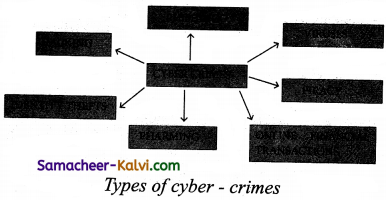
Question 12.
Write a short note on unauthorized Access.
Answer:
Unauthorized access is when someone gains access to a website, program, server, service, or other system by breaking into a legitimate user account. For example, if someone tries guessing a password or username for an account that was not theirs until they gained access, it is considered an unauthorized access.
To prevent unauthorized access, Firewalls, Intrusion Detection Systems (IDS), Virus and Content Scanners, Patches and Hot fixes are used.
![]()
Question 13.
What is Hacking? Give the diagrammatic representation of hacking.
Answer:
Hacking is intruding into a computer system to steal personal data without the owner’s permission or knowledge (like to steal a password). It is also gaining unauthorized access to a computer system and altering its contents. It may be done in pursuit of a criminal activity or it may be a hobby.
Hacking may be harmless if the hacker is only enjoying the challenge of breaking systems defenses, but such ethical hacking should be practiced only as controlled experiments. Figure below shows a diagrammatic representation of Hacking.
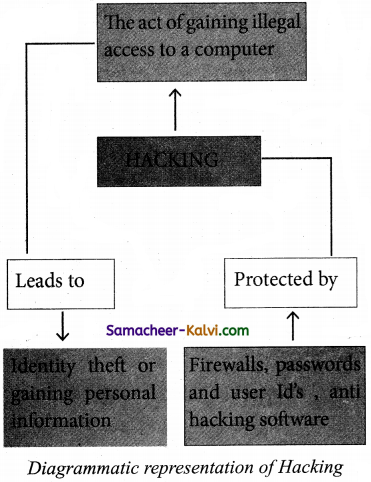
Question 14.
State some reasons why websites use cookies.
Answer:
Websites typically use cookies for the following reasons:
- To collect demographic information about who has visited the Website.
- Sites often use this information to track how often visitors comfe to the site and how long they remain on the site.
- It helps to personalize the user’s experience on the Web site.
- Cookies can help store personal information about users so that when a user subsequently returns to the site, a more personalized experience is provided.
![]()
Question 15.
Write a lote on public key encryption.
Answer:
Public key encryption is also called Asymmetric encryption. It uses the concept of a key value pair, a different key is used for the encryption and decryption process. One of the keys is typically known as the private key and the other is known as the public key.
The private key is kept secret by the owner and the public key is either shared amongst authorized recipients or made available to the public at large.
The data encrypted with the recipient’s public key can only be decrypted with the corresponding private key. Figure below shows the public key encryption.
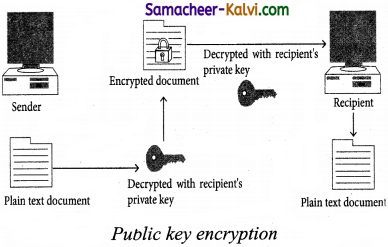
Question 16.
Write a short note on Asymmetric encryption in Digital certificate.
Answer:
A digital certificate in a client-server model of communication is an example of Asymmetric Encryption. A certificate is a package of information that identifies a user and a server. It contains information such as an organization’s name, the organization that issued the certificate, the user’s email address and country and user’s public key.
When a server and a client require a secure encrypted communication, they send a query over the network to the other party, which sends back a copy of the certificate. The other party’s public key can be extracted from the certificate. A certificate can also be used to uniquely identify the holder.
![]()
Question 17.
What do you mean by Information Technology Act?
Answer:
In the 21st century, Computer, Internet and ICT or e-revolution has changed the life style of the people. Today
paper based communication has been substituted by e-communication. Accordingly we have new terminologies like cyber world, e-transaction, e-banking, e-retum and e-contracts.
Apart from positive side of e-revolution there is also negative side of computer, that is, the internet and ICT in the hands of criminals which has become a weapon of offence. Accordingly a new panel of members emerged to tackle the problems of cyber crimes in cyber space i.e., Cyber Law or Cyber Space Law or Information Technology Law or Internet Law.
In India Cyber law and IT Act 2000, modified in 2008 are being articulated to prevent computer crimes. IT Act 2000 is an act to provide legal recognition for transactions carried out by means of Electronic Data Interchange (EDI) and other means of electronic communication. It is the primary law in India dealing with cybercrime and electronic commerce (e-commerce). e-Commerce is electronic data exchange or electronic filing of information.
Question 18.
Explain in detail about the cyber security threats in detail.
Answer:
Most of the individuals and enterprises are facing problems due to the weaknesses inherent in security systems and compromised organizational infrastructures. Different types of Cyber Security Threats are categorized as below:
Social engineering:
A misuse of an individual’s weakness, achieved by making them to click malicious links or by physically accessing the computer through tricks.
Eg: Phishing and pharming.
Phishing:
Phishing is a type of computer crime used to attack, steal user data, including login name, password and credit card numbers. It occurs when an attacker targets a victim into opening an e-mail or an instant text message. The attacker uses phishing to distribute malicious links or attachments that can perform a variety of functions, including the extraction of sensitive login credentials from victims.
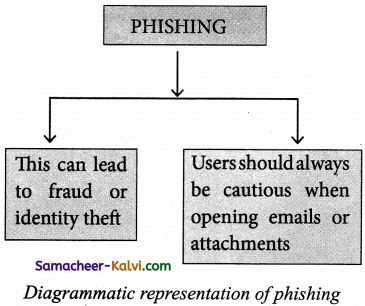
Pharming:
Pharming is a scamming practice in which malicious code is installed on a personal computer or server, misdirecting users to fraudulent websites without their knowledge or permission. Pharming has been called “phishing without a trap”. It is another way hackers attempt to manipulate users on the Internet. It is a cyber-attack intended to redirect a website’s traffic to a fake site.
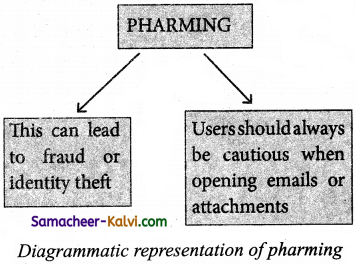
Man In The Middle (MITM):
Man-in-the- middle attack (MITM; also Janus attack) is an attack where the attacker secretly relays and possibly alters the communication between two parties who believe they are directly communicating with each other.
Eg: Suppose Alice wishes to communicate with Bob. Meanwhile, Mallory wishes to intercept the conversation to overhear and optionally to deliver a false message to Bob.
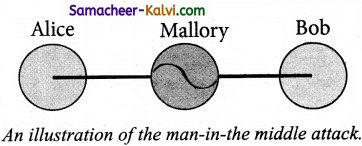
![]()
Question 19.
What are cookies? Why cookies are used in websites? Explain with example.
Answer:
A cookie is a small piece of data sent from a website and stored on the user’s computer memory (Hard drive) by the user’s web browser while the user is browsing internet. It is also called HTTP cookie, web cookie, Internet cookie, browser cookie, or simply cookie. Websites use cookies for the following reasons:
- To collect demographic information about who has visited the Website.
- Sites often use this information to track how often visitors come to the site and how long they remain on the site.
- It helps to personalize the user’s experience on the Website.
- Cookies can help store personal information about users so that when a user subsequently returns to the site, a more personalized experience is provided.
Some online shopping sites will make recommendations to users based on their previous purchases. It helps to monitor advertisements. Cookies do not act maliciously on computer system. They are merely text files that can be deleted at any time.
Cookies cannot be used to spread viruses and they cannot access your hard drive. Any personal information that you provide to a Website, including credit card information, will most likely be stored in a cookie unless the cookie feature is explicitly turned off in your browser. This is the way in which cookies threaten privacy.
Question 20.
Explain the working of
(i) Firewall
(ii) Proxy servers
Answer:
(i) Firewall:
It is a computer network security based system that monitors and controls incoming and outgoing network traffic based on predefined security rules. A firewall establishes a block between a trusted internal computer network and entrusted computer outside the network.
They are categorized as network-based or host-based. Network based firewalls are positioned on the gateway computers of LANs [Local Area Network], WANs [Wide Area Network] and intranets. Host-based firewalls are positioned on the network node itself. The host-based firewall may be a service as a part of the operating system or an agent application such as endpoint security or protection.
Each has advantages and disadvantages. However, each has a role in layered security. Firewalls also vary in type depending on where communication originates, where it is intercepted, and the state of communication being traced.
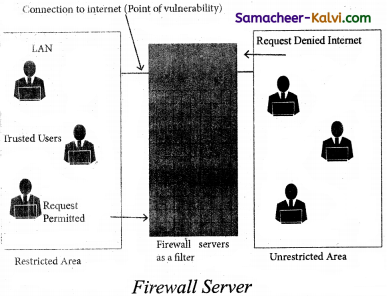
Proxy servers:
A proxy server acts as an intermediary between the end users and a web server. A client connects to the proxy server, requesting some service, such as a file, connection, web page or other resources available from a different server. The proxy server examines the request, checks authenticity and grants the request based on that. Proxy servers typically keep the frequently visited site addresses in its cache which leads to improved response time.
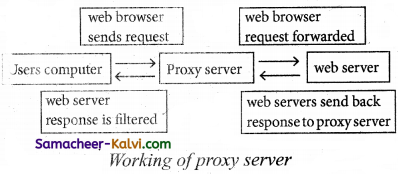
![]()
Question 21.
Explain the function of Digital signature.
Answer:
Digital signatures are based on asymmetric cryptography and can provide assurances of evidence to origin, identity and status of an electronic document, transaction or message, as well as acknowledging informed by the signer.
To create a digital signature, signing software (email) creates a one-way hash of the electronic data to be signed. The user’s private key to encrypt the hash, returning a value that is unique to the hashed data. The encrypted hash, along with other information such as the hashing algorithm, forms the digital signature.
Any change in the data, even to a single bit, results in a different hash value. This attribute enables others to validate the integrity of the data by using the signer’s public key to decrypt the hash. If the decrypted hash matches a second computed hash of the same data, it proves that the data hasn’t changed since it was signed.
If the two hashes don’t match, the data has either been tampered with in some way (indicating a failure of integrity) or the signature was created with a private key that doesn’t correspond to the public key presented by the signer (indicating a failure of authentication). Figure below shows the function of a digital signature.
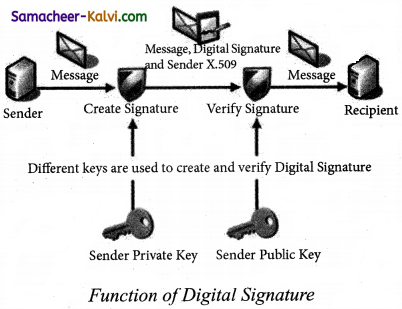
Question 22.
Explain in detail about cracking.
Answer:
Cracking is where someone edits a program source so that the code can be exploited or modified. A cracker (also called a black hat or dark side hacker) is a malicious or criminal hacker. “Cracking” means trying to get into computer systems in order to steal, corrupt or illegitimately view data.
A cracker is someone who breaks into someone else’s computer system, often on a network, bypassing passwords or licenses in computer programs. Software cracking is the most often used type of cracking which is nothing but removing the encoded copyprotection. There is another type of cracking called password cracking. This is mainly used to crack the passwords. Password cracking can be performed either by using an automated program or can be manually realized.
Interesting fact about cracking is social engineering. It is a method of getting passwords and information using human weakness. These crackers trick people, not software. They can use just the phone forgetting information, they can pretend being your friend and talk to you on Internet Relay Chat (IRC) or by Instant messenger, e-mail can also be a source for them. They may send official e-mail requesting some sensitive information. It may look like a legitimate e-mail from bank or other official institution.
The other method that uses social engineering crackers is password guessing. They find your personal information from some personal data/facts and try to guess a password. Usually a cracker maintains knowledge of the vulnerabilities he or she finds and exploits them for personal advantage, not revealing them to either to the general public or to the manufacturer.
![]()
Question 23.
What is harvesting?
Answer:
A person or program collects login and password information from a legitimate user to illegally gain access to others account(s).
Question 24.
What are Warez?
Answer:
Commercial programs that are made available to the public illegally are called warez.
Question 25.
Write a short note on cracking.
Answer:
“Cracking” means trying to get into computer systems in order to steal, corrupt or illegitimately view data.
Question 26.
Write two types of cyber attacks.
Answer:
Worms:
They are self-repeating and do not require a computer program to attach themselves. Worms continually look for vulnerabilities and report back to the author of the worm when weaknesses are discovered.
Spyware:
It can be installed automatically on the computer when the attachments are open, by clicking on links or by downloading infected software.
![]()
Question 27.
What is a Cookie?
Answer:
A cookie is a small piece of data sent from a website and stored on the user’s computer memory (Hard drive) by the user’s web browser while the user is browsing internet.
Question 28.
What is the role of firewalls?
Answer:
A firewall is a computer network security based system that monitors and controls incoming and outgoing network traffic based on predefined security rules. A firewall commonly establishes a block between a trusted internal computer network and entrusted computer outside the network.
They are generally categorized as network- based or host-based. Network based firewalls are positioned on the gateway computers of LANs [Local Area Network], WANs [Wide Area Network] and intranets. Host-based firewalls are positioned on the network node itself. The host-based firewall may be a service as a part of the operating system or an agent application such as endpoint security or protection.
Each has advantages and disadvantages. However, each has a role in layered security. Firewalls also vary in type depending on where communication originates, where it is intercepted and the state of communication being traced.
Question 29.
Write about encryption and decryption.
Answer:
Encryption and decryption are processes that ensure confidentiality that only authorized persons can access the information.
Encryption is the process of translating the plain text data (plaintext) into random and mangled data (called cipher-text).
Decryption is the reverse process of converting the cipher-text back to plaintext. Encryption and decryption are done by cryptography.
![]()
Question 30.
Explain symmetric key encryption.
Answer:
Symmetric encryption is a technique to use the same key for both encryption and decryption. The main disadvantage of the symmetric key encryption is that all authorized users involved, have to exchange the key used to encrypt the data before they can decrypt it.
If any user intercepts the key information, they may read all messages. The working of symmetric key encryption:
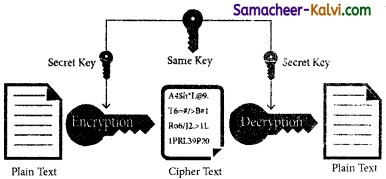
Question 31.
What are the guidelines to be followed by any computer user?
Answer:
The following guidelines should be observed by computer users:
- Honesty: Users should be truthful while using the internet.
- Confidentiality: Users should not share any important information with unauthorized people.
- Respect: Each user should respect the privacy of other users.
- Professionalism: Each user should maintain professional conduct.
- Obey The Law: Users should strictly obey the cyber law in computer usage.
- Responsibility: Each user should take ownership andresponsibility for their actions.
![]()
Question 32.
What are ethical issues? Name some.
Answer:
An Ethical issue is a problem or issue that requires a person or organization to choose between alternatives that must be evaluated as right (ethical) or wrong (unethical). These issues must be addressed and resolved to have a positive influence in society.
Some of the common ethical issues are:
- Cybercrime
- Software Piracy
- Unauthorized Access
- Hacking
- Use of computers to commit fraud
- Sabotage in the form of viruses
- Making false claims using computers.
Question 33.
What are the various crimes happening using computer?
Answer:
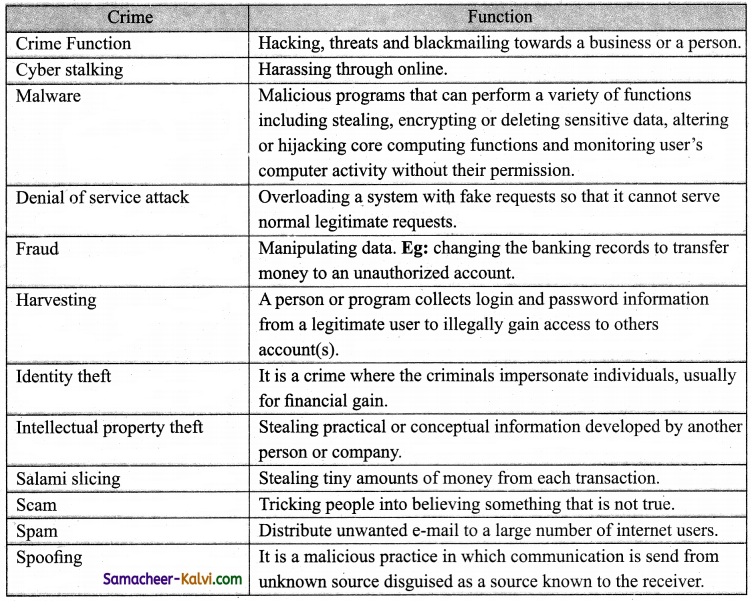
![]()
Question 34.
What is piracy? Mention the types of piracy. How can it be prevented?
Answer:
Piracy is “unauthorized copying of software”. Figure below shows a diagrammatical representation of software piracy.
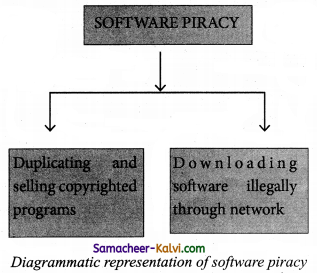
Most of the commercial software is licensed for use at a single computer site or for use by only one user at any time.When a user buys any software, he becomes a licensed user for that software. He is allowed to make copies of the program for backup purposes, but it is against the law to distribute duplicate copies to others. Such illegal copying and distribution of commercial software should not be practiced.
An entirely different approach to software piracy is called shareware, acknowledges the futility of trying to stop people from copying software and instead relies on people’s honesty. Shareware publishers encourage users to give copies of programs to friends and colleagues but ask everyone who uses that program regularly to pay a registration fee to the program’s author directly.
![]()
Question 35.
Write the different types of cyber attacks.
Answer:
Cyber Attacks and Functions:
Virus:
- A virus is a small piece of computer code that can repeat itself and spreads from one computer to another by attaching itself to another computer file. One of the most common virus is Trojan.
- Trojan virus is a program that appears to perform one function (for example, virus removal) but actually performs malicious activity when executed.
Worms:
- Worms are self- repeating and do not require a computer program to attach themselves.
- Worms continually look for vulnerabilities and report back to the author of the worm when weaknesses are discovered.
Spyware:
Spyware can be installed on the computer automatically when the attachments are open, by clicking on links or by downloading infected software.
Ransomware:
- Ransomware is a type of malicious program that demands payment after launching a cyber-attack @n a computer system.
- This type of malware has become increasingly popular among criminals and costs the organizations millions each year.
![]()
Choose the correct answer:
Question 1.
________ is a communication media which is easily accessible and open to all.
(a) Mobile
(b) TV
(c) Computer
(d) Internet
Answer:
(d) Internet
Question 2.
______ is wide spread through computers, mobile phones and internet.
(a) Information Technology
(b) Intranet
(c) LAN
(d) WAN
Answer:
(a) Information Technology
Question 3.
_____ play an important role in the daily lives of individuals and business.
(a) Computer
(b) Smart Phones
(c) Internet
(d) Tablets
Answer:
(a) Computer
![]()
Question 4.
A ________ is a crime which involves computer and network.
(a) network crime
(b) system crime
(c) firewall
(d) cyber-crime
Answer:
(d) cyber-crime
Question 5.
__________ poses threats to the integrity, safety and survival of most business systems.
(a) Cyber-crime
(b) Cookies
(c) Firewall
(d) System crime
Answer:
(a) Cyber-crime
Question 6.
Ethics means:
(a) What is Right alone
(b) What is wrong and What is Right
(c) What is wrong alone
(d) None
Answer:
(b) What is wrong and What is Right
![]()
Question 7.
__________ is becoming very popular among business as it helps them to reach a wide range of customers faster.
(a) e-commerce
(b) Hacking
(c) e-shopping
(d) Electronic mail
Answer:
(a) e-commerce
Question 8.
_________ users should not share any important information with unauthorized people.
(a) Confidentiality
(b) Professionalism
(c) Responsibility
(d) Honesty
Answer:
(a) Confidentiality
Question 9.
________ is an ethical issue.
(a) Data protection
(b) Data hiding
(c) Hacking
(d) Web application
Answer:
(c) Hacking
![]()
Question 10.
Cyber crime is an ______ crime.
(a) Green-collar
(b) Red-collar
(c) Blue-collar
(d) White-collar
Answer:
(d) White-collar
Question 11.
_________ is an example for cyber crime.
(a) Legal money transfer in internet
(b) Chatting
(c) e-shopping
(d) Illegal money transfer in internet
Answer:
(d) Illegal money transfer in internet
Question 12.
______ is a set of moral principles that govern the behaviour of an individual in a society.
(a) Ethics
(b) Crime
(c) DPA
(d) Computer ethics
Answer:
(a) Ethics
![]()
Question 13.
______ is a set of moral principles that regulate the use of computers by users.
(a) Trolling
(b) Computer ethics
(c) Computer crime
(d) Hacking
Answer:
(b) Computer ethics
Question 14.
Hacking, threats and blackmailing towards a business or a person is a:
(a) IT literacy
(b) Internet access
(c) Crime function
(d) Privacy
Answer:
(c) Crime function
Question 15.
Tricking people into that is not true is believing something that is not true is:
(a) scan
(b) scam
(c) share
(d) internet trolls
Answer:
(b) scam
![]()
Question 16.
Distributing unwanted e-mail to a large number of internet users is:
(a) scam
(b) spam
(c) scan
(d) service
Answer:
(b) spam
Question 17.
_______ is a malicious practice in which communication is send from unknown source disguised as a source known to the receiver.
(a) Spoofing
(b) Spooling
(c) Copy righted
(d) Public-domain
Answer:
(a) Spoofing
Question 18.
Overloading a system with fake requests so that it cannot serve normal legitimate requests is:
(a) Denial of service attack
(b) Intellectual property theft
(c) Harvesting
(d) Cyber stalking
Answer:
(a) Denial of service attack
![]()
Question 19.
Harassing through online is:
(a) Cyber taking
(b) Cyber stalking
(c) Computer crime
(d) Identity theft
Answer:
(b) Cyber stalking
Question 20.
Stealing tiny amounts of money from each transaction is:
(a) Salami slicing
(b) Spoofing
(c) Harvesting
(d) Malware
Answer:
(a) Salami slicing
Question 21.
Stealing practical or conceptual information developed by another person or company is:
(a) Denial of service attack
(b) Intellectual property theft
(c) Identity theft
(d) Fraud
Answer:
(b) Intellectual property theft
![]()
Question 22.
Manipulating data, like changing the banking records to transfer money to an unauthorized account is:
(a) Stealing
(b) Fraud
(c) Harmful
(d) Theft
Answer:
(b) Fraud
Question 23.
________ is unauthorized copying of software.
(a) Crime function
(b) Cyber stalking
(c) Salami slicing
(d) Piracy
Answer:
(d) Piracy
Question 24.
________ acknowledges the futility of trying to stop people from copying software and instead relies on people’s honesty.
(a) Spyware
(b) Shareware
(c) Copyware
(d) Freeware
Answer:
(b) Shareware
![]()
Question 25.
The expansion of IDS is:
(a) Intrusion Detection Systems
(b) Intrusion Data Systems
(c) Interaction Data Systems
(d) Intermediate Detection Systems
Answer:
(a) Intrusion Detection Systems
Question 26.
The expansion of IRC is:
(a) Interact Relay Chat
(b) Internet Relay Chat
(c) Internet Replay Chat
(d) Interact Replay Chat
Answer:
(b) Internet Relay Chat
Question 27.
A ________ is someone who breaks into someone else computer system, often on a network.
(a) cracker
(b) cyber attack
(c) virus
(d) hacking
Answer:
(a) cracker
![]()
Question 28.
_______ can be installed on the computer automatically when the attachments are opened. .
(a) Spyware
(b) Ransomware
(c) Virus
(d) Worms
Answer:
(a) Spyware
Question 29.
______ is a type of malware that has become increasingly popular among criminals.
(a) Virus
(b) Worms
(c) Ransomware
(d) Spyware
Answer:
(c) Ransomware
Question 30.
__________ is a type of software designed through which the criminals gain illegal access to software and cause damage.
(a) Freeware
(b) Spyware
(c) Malware
(d) Ransomware
Answer:
(c) Malware
![]()
Question 31.
Phishing and pharming are examples of:
(a) computer engineering
(b) network engineering
(c) software engineering
(d) social engineering
Answer:
(d) social engineering
Question 32.
_______ computer crime used to attack, steal user data, including login name, password and credit card numbers.
(a) Farming
(b) Phishing
(c) Crimes
(d) Trojan
Answer:
(b) Phishing
Question 33.
__________ is a scamming practice in which malicious code is installed on a personal computer or server.
(a) Phishing
(b) Pharming
(c) Scam
(d) Scanning
Answer:
(b) Pharming
![]()
Question 34.
______ has been called “Phishing without a trap”.
(a) Cookie
(b) Pharming
(c) MITM
(d) Firewall
Answer:
(b) Pharming
Question 35.
The expansion of MITM:
(a) Money-in-the-middle
(b) Man-in-the-middle
(c) Middle-in-the-man
(d) Middle-in-the-money
Answer:
(b) Man-in-the-middle
Question 36.
The expansion of LAN is:
(a) Local Area Network
(b) Local Air Network
(c) Local Area Node
(d) List Area Network
Answer:
(a) Local Area Network
![]()
Question 37.
The expansion of WAN is:
(a) Wide Area Network
(b) World Area Network
(c) Wide Area Node
(d) World Area Node
Answer:
(a) Wide Area Network
Question 38.
A _________ establishes a block between a trusted internal computer network and entrusted computer outside the network.
(a) cookies
(b) browsers
(c) firewall
(d) scam
Answer:
(c) firewall
Question 39.
A _________ server acts as an intermediary between the end users and a web server.
(a) client
(b) proxy
(c) firewalls
(d) cookies
Answer:
(b) proxy
![]()
Question 40.
_______ typically keep the frequently visited site addresses in its cache which leads to improved response time.
(a) Client servers
(b) MITM
(c) Pharming
(d) Proxy servers
Answer:
(d) Proxy servers
Question 41.
________ is the process of translating the plain text data into random and mangled data.
(a) Encryption
(b) Decryption
(c) Translator
(d) Compiler
Answer:
(a) Encryption
Question 42.
Akey is a piece of information that determines the functional output of a cryptographic algorithm in:
(a) Cryptography
(b) Parameter
(c) Encryption
(d) Filters
Answer:
(a) Cryptography
![]()
Question 43.
There are _________ types of encryption.
(a) two
(b) three
(c) four
(d) five
Answer:
(a) two
Question 44.
_______ encryption uses the same key for both encryption and decryption.
(a) Asymmetric key
(b) Symmetric key
(c) Public key
(d) Private key
Answer:
(b) Symmetric key
Question 45.
_________ key encryption is also called Asymmetric encryption.
(a) Auto
(b) Private
(c) Protected
(d) Public
Answer:
(d) Public
![]()
Question 46.
The _______ key is kept secret by the owner.
(a) symmetric
(b) private
(c) protected
(d) cryptography
Answer:
(b) private
Question 47.
_________ key is either shared amongst authorized recipients.
(a) Public
(b) Protected
(c) Decrypted
(d) Encrypted
Answer:
(a) Public
Question 48.
A __________ in a client-server model of communication is one of the example of Asymmetric Encryption.
(a) digital certificate
(b) client certificate
(c) server certificate
(d) client-server certificate
Answer:
(a) digital certificate
![]()
Question 49.
________ provides assurances of evidence to origin, identity and status of an electronic document.
(a) Hand signature
(b) Cyber signature
(c) Digital signature
(d) Key signature
Answer:
(c) Digital signature
Question 50.
The expansion for EDI is:
(a) Electrical Data Interchange
(b) Electronic Data Interchange
(c) Electrical Data Internet
(d) Electronic Data Internet
Answer:
(b) Electronic Data Interchange
Question 51.
Match the following:
| (i) Ethics | (a) Electronic data exchange. |
| (ii) Cyber crime | (b) Asymmetric encryption. |
| (iii) Public key | (c) White collar crime |
| (iv) e commerce | (d) What is wrong and what is right. |
(a) (i) – (a); (ii) – (b); (iii) – (d); (iv) – (c)
(b) (i) – (b); (ii) – (c); (iii) – (a); (iv) – (d)
(c) (i) – (d); (ii) – (c); (iii) – (b); (iv) – (a)
(d) (i) – (a); (ii) – (c); (iii) – (b)- (iv) – (d)
Answer:
(c) (i) – (d); (ii) – (c); (iii) – (b); (iv) – (a)
![]()
Question 52.
Choose the odd man out:
(a) Honesty
(b) Confidentiality
(c) Responsibility
(d) Hacking
Answer:
(d) Hacking
Question 53.
Choose the correct statement about guidelines of ethics:
(a) Users should not be truthful while using the internet.
(b) Users should share any important information with unauthorised people.
(c) User should not maintain professional conduct.
(d) User should strictly obey the cyber law in computer usage.
Answer:
(d) User should strictly obey the cyber law in computer usage.
Question 54.
Choose the incorrect statement about ethics:
(a) Do not use unauthorised user accounts.
(b) Use pirated software only.
(c) Do not steel other’s passwords.
(d) Do not hack.
Answer:
(b) Use pirated software only.
![]()
Question 55.
Assertion (A):
Encryption and decryption are processes that ensure confidentiality that only authorized persons can access the information.
Reason (R):
Encryption is the process of converting the cipher- text back to plain text.
(a) Both A and R are true and R is the correct explanation for A.
(b) Both A and R are true, but R is not the correct explanation for A.
(c) A is true, but R is false.
(d) A is false, but R is true.
Answer:
(c) A is true, but R is false.
Question 56.
Which of the following deals with procedures, practices and values?
(a) Piracy
(b) Programs
(c) Virus
(d) Computer ethics
Answer:
(d) Computer ethics
Question 57.
Commercial programs made available to the public illegally are known as:
(a) freeware
(b) warez
(c) free software
(d) software
Answer:
(b) warez
![]()
Question 58.
Which one of the following are self-repeating and do not require a computer program to attach themselves?
(a) Viruses
(b) Worms
(c) Spyware
(d) Trojans
Answer:
(b) Worms
Question 59.
Which one of the following tracks a user visits a website?
(a) Spyware
(b) Cookies
(b) Cookies
(d) Trojans
Answer:
(b) Cookies
Question 60.
Which of the following is not a malicious program on computer systems?
(a) Worms
(b) Trojans
(c) Spyware
(d) Cookies
Answer:
(d) Cookies
![]()
Question 61.
A computer network security that monitors and controls incoming and outgoing traffic is:
(a) Cookies
(b) Virus
(c) Firewall
(d) Worms
Answer:
(c) Firewall
Question 62.
The process of converting cipher text to plain text is called:
(a) Encryption
(b) Decryption
(c) Key
(d) Proxy server
Answer:
(b) Decryption
Question 63.
e-commerce means:
(a) electronic commerce
(b) electronic data exchange
(c) electric data exchange
(d) electronic commercialization.
Answer:
(a) electronic commerce
![]()
Question 64.
Distributing unwanted e-mail to others is called:
(a) scam
(b) spam
(c) fraud
(d) spoofing
Answer:
(b) spam
Question 65.
Legal recognition for transactions are carried out by:
(a) Electronic Data Interchange
(b) Electronic Data Exchange
(c) Electronic Data Transfer
(d) Electrical Data Interchange
Answer:
(a) Electronic Data Interchange